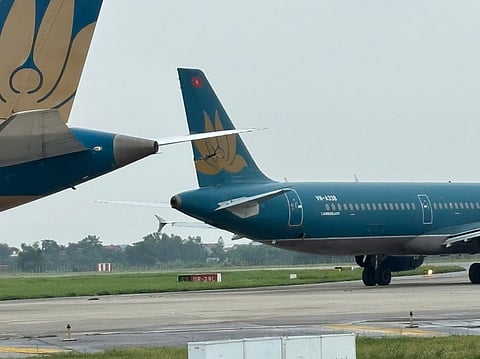Video: Vietnam airlines jets collide on Hanoi taxiway, flights for hundreds halted
All 386 passengers returned to Terminal 1; Vietnam Airlines rebooked them on new flights

Two Vietnam Airlines aircraft collided while taxiing at Noi Bai International Airport in Hanoi on June 27, grounding both planes and disrupting travel for hundreds of passengers, according to media reports.
At 2:23 pm (local time), a Boeing 787-9 Dreamliner (VN-A863) bound for Ho Chi Minh City clipped the tail of a stationary Airbus A321 (VN-A338), which was waiting to depart for Dien Bien, said the Northern Airports Authority.
The collision happened at the intersection of taxiways S and S3, under clear weather conditions. The Boeing’s right wingtip struck the Airbus’s vertical stabiliser, causing visible damage to both aircraft and scattering debris across the tarmac.
All 386 passengers on both flights were unharmed. They were returned to Terminal T1, and Vietnam Airlines arranged alternate flights.
Human error suspected
Preliminary findings suggest the Airbus may have stopped short of the designated holding point, possibly contributing to the incident. With weather ruled out, investigators are focusing on operational lapses or miscommunication between pilots and ground controllers.
Both aircraft were towed to remote stands for technical inspection, and a formal investigation is underway by the Civil Aviation Authority of Vietnam (CAAV) and the Northern Airports Authority.
Airline faces operational strain
The crash adds Vietnam Airlines to a list of global carriers—Ryanair, KLM, Air China, Royal Brunei, and Asiana—linked to past ground collisions, highlighting the dangers that exist even off the runway.
The airline scrambled to minimise disruption, but the grounding of two key aircraft—especially on the busy Hanoi–Ho Chi Minh City route—caused ripple effects across its domestic network.
Spotlight on safety protocols
As Vietnam’s aviation sector booms, questions are emerging about whether current airport infrastructure and ground-handling procedures are up to the task.
Industry analysts, citing Travel and Tour World, warn that this collision could trigger a comprehensive overhaul—ranging from updated taxiway rules and tighter pilot-controller communications to enhanced training standards for ground crews. The incident underscores a vital truth: even on the tarmac, ensuring aviation safety requires relentless attentiveness.
Sign up for the Daily Briefing
Get the latest news and updates straight to your inbox


